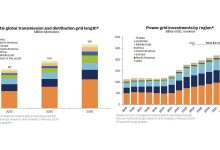Chevron Sets Net Zero Aspiration and New GHG Intensity Target: Advancing A Lower Carbon Future
Chevron issued an updated climate change resilience report that further details the company’s ambition to advance their lower carbon future. Chevron adopted a 2050 net zero aspiration for equity upstream Scope 1 and 2 emissions. The TCFD-aligned report describes how Chevron is incorporating Scope 3 emissions into its greenhouse gas emission targets by establishing a Portfolio Carbon Intensity (PCI) target inclusive of Scopes 1 and 2 as well as Scope 3 emissions from the use of its products.
“Solutions start with problem solving, which is exactly what the people of Chevron do – and have excelled at for over 140 years,” said Michael Wirth, Chevron’s chairman and CEO. “This report offers further insights about our strategy, how we are investing in lower-carbon businesses and why we believe this is an exciting time to be in the energy industry.”
Chevron’s new PCI target assists with transparent carbon accounting and company comparison from publicly available data. The target covers the full value chain, including Scope 3 emissions from the use of products. The company has set a greater than 5 percent carbon emissions intensity reduction target from 2016 levels by 2028. This target is aligned with Chevron’s strategy which allows flexibility to grow its traditional business, provided it remains increasingly carbon-efficient, and pursue growth in lower-carbon businesses. Chevron plans to publish a PCI methodology document and online tool to enable third parties to calculate PCI for energy companies.
Chevron’s 2050 equity upstream Scopes 1 and 2 net zero aspiration builds on the company’s disciplined approach to target setting and action. The path to this net zero aspiration anticipates partnerships with multiple stakeholders and progress in technology, policy, regulations, and offset markets.
“We regularly engage with stakeholders and investors to understand their views and to be responsive to their increasing expectations on all issues, including ESG,” said Dr. Ronald Sugar, Chevron’s lead director. “Our updated report demonstrates our goal to partner with many stakeholders to work toward a lower carbon future.”
Strategy
The world’s energy demands in recent years are greater than at any time in human history, and most published outlooks conclude that fossil fuels will remain a significant part of an energy system that increasingly incorporates lower carbon sources of supply.
Within this context, Chevron align their strategy with areas in which they have a competitive advantage and in which they see potential to generate increased value for the investors.
Chevron’s strategic process supports their ability to operate in a lower carbon policy environment. For example, they use carbon prices and derived carbon costs in business planning, investment decisions, impairment reviews, reserves calculations, and evaluation of opportunities for carbon reduction and new energies. Chevron believes that lower carbon–intensity oil and gas assets will remain economically competitive under a wide range of future scenarios. They believe that their asset mix enables them to be flexible in response to potential changes in supply and demand, even in lower carbon scenarios like the hypothesized NZE 2050 scenario.
Rewarding the most carbon-efficient producers
Chevron supports the Paris Agreement and its goal of “holding the increase in the global average temperature to well below 2° C above pre-industrial levels and pursuing efforts to limit the temperature increase to 1.5° C above pre-industrial levels,” which per the IPCC implies reaching global net zero in the second half of this century. They believe that the optimal approach is to drive the most efficient and cost-effective reductions economywide, paired with natural and technological emissions removals. Narrow sectoral or geographic metrics are less efficient than broad economywide solutions, which are uniquely able to incentivize the most efficient and cost-effective reductions. Chevron supports a price on carbon, applied as widely and broadly as possible, as the best approach to reduce emissions. They work to encourage national policies to support international linkages (for example, through Article 6 of the Paris Agreement), with the goal of ultimately building up to a liquid and integrated global carbon market.
Individual companies contribute to achieving the goals of the Paris Agreement through their participation in policies that may be included in the NDCs of the countries in which the companies operate. Chevron works with governments to encourage well-designed policies that can strengthen the NDCs, such as carbon pricing and rewarding the most efficient and least carbon-intensive producers. Most energy forecasts agree that oil and gas will continue to be a significant source of energy—even in a net zero scenario for years to come. Chevron believes the transparent reporting of performance will enable the market to reward the most carbon-efficient producers.
Keys to a lower carbon future
Chevron believes removals and hydrogen are key to a lower carbon future. Improvements in technology can reduce energy costs, lower emissions, and influence the energy mix by changing the relative competitiveness of different energy types. Three of the most prominent areas of investment include natural and technological CO2 removals; hydrogen; and battery storage. Removals and hydrogen in particular are important technologies to assist in the decarbonization of hard-to-abate sectors.
Removals: The IPCC 1.5° C report pointed out that many pathways to achieving the < 2° C goal will require “negative emissions” approaches. Negative emissions, or CO2 removals, are often classified as natural climate solutions and technology removals, like carbon capture. Both can be essential tools in mitigating GHG emissions and meeting the goals of the Paris Agreement. According to the IEA’s Energy Technology Perspectives 2020 report, CCUS is expected to play a central role as one of four key pillars of global energy transitions, alongside renewables-based electrification, bioenergy, and hydrogen.
CCUS may also unlock faster decarbonization of carbon-intensive production processes, such as cement manufacturing.
Hydrogen: Hydrogen is a versatile energy carrier, with potential as a lower carbon fuel, particularly in sectors that are hard to decarbonize. Under some scenarios, demand for blue and green hydrogen could more than triple by 2050 if costs come down and infrastructure is built out. Targeted government policies can encourage research and development to drive down costs and improve performance so hydrogen can become commercially viable. Policy can also help lower the risk of investment for first movers by enabling development of supply chains and infrastructure that drive down costs and enable economies of scale.
Battery storage: Over the past decade, there has been notable cost reduction and performance improvement in lithium-ion (Li-ion) batteries and other storage technologies. Such progress, combined with a drop in the cost of producing renewable energy and advancements in other technologies, such as smart grid and demand-management innovations, has the potential to increase electrification in sectors like light-duty passenger transportation. These advances facilitate increased use of renewable energy in electricity generation and help mitigate the problem of intermittency.
However, even with these improvements in energy storage, many leading energy experts agree that additional technology breakthroughs are needed to enable wider scaling of renewables and decarbonization in other hard-to-abate sectors.
CCUS and hydrogen are the among the most promising of these other technologies.
IEA’s NZE 2050
One example of a lower carbon scenario is the IEA’s Net Zero by 2050 scenario. NZE 2050 is limited to the energy sector and thus does not address natural climate solutions and impacts to land-use change that occur in non-energy sectors. The IEA states that the “pathway remains narrow and extremely challenging, requiring all stakeholders—governments, businesses, investors, and citizens—to take action this year and every year after so that the goal does not slip out of reach.”
NZE 2050 is a hypothetical scenario that assumes what we believe to be a highly unlikely transformation of the global energy system from one currently supplied primarily by fossil fuels to a smaller one dominated by renewable energy, with renewables and bioenergy increasing from 16 percent to 67 percent of the global energy mix by 2050. It requires immediate and unprecedented action: globally coordinated policy design, strong international cooperation, vast capital redeployment, new infrastructure build-out, accelerated technology deployment, and a threefold improvement in energy efficiency that to date has not been forthcoming. NZE 2050 also assumes carbon prices reaching as much as USD 250 per tonne in advanced economies by 2050.
Under NZE 2050, the global economy moves away from one largely powered by fossil fuels to one powered predominantly by renewable energy. In this scenario, steep declines in medium- and long-term oil and gas demand put downward pressure on prices.
Chevron believes the likelihood of the IEA’s NZE 2050 scenario is remote. It is not reflective of any realistic current projections, especially in terms of global cooperation regarding the adoption of effective global policies that would transform the global energy mix so dramatically by 2050. For example, in its International Energy Outlook 2021, the U.S. Energy Information Administration projects in its reference case that by 2050 global energy consumption will increase substantially as a result of population and economic growth and that oil and natural-gas production will also continue to grow. Moreover, the wide range of unpredictable variables and externalities affecting long-term outcomes during this period of uncertainty and energy transition makes long-term modeling of this scenario inherently speculative. Therefore, Chevron does not rely on the NZE 2050 scenario for its business planning. Nonetheless, they have conducted a scenario test of the IEA’s NZE 2050 demand projections, as well as its oil, gas, and carbon price projections, to test against their portfolio. The NZE 2050 scenario outlined is not a prediction.
The IEA does not directly provide all market detail required to run a scenario analysis (e.g., regional product consumption).
Regional demand information from the IEA’s Sustainable Development Scenario was used as a guide to interpolate from the available NZE 2050 information to create the regional input estimates necessary to run the scenario.
Chevron’s assumptions employed in this analysis included the following:
- Chevron would have extremely aggressive growth of CCUS, offsets, hydrogen, renewable fuels, and renewable natural gas.
- Refining and petrochemicals margins were decreased by the percentage change in Brent prices relative to their 2021 Business Plan price forecast.
- Marketing volumes were based on regional gasoline and diesel demand.
The future of energy
Chevron believes the future of energy will be lower carbon, and they intend to be a leader today and in that future. Their strategy is straightforward: Be a leader in efficient and lower carbon production of traditional oil and gas energy, in high demand today and for years to come, while growing the lower carbon businesses that will be a bigger part of the future.







